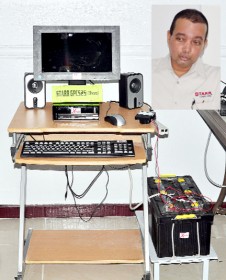With the advent of its new low-energy system, Starr Computers has begun to shift the focus of its operations to manufacturing and export and is targeting the border regions of Brazil and Suriname as key potential markets, its Director Michael Mohan told Stabroek Business in an interview on Tuesday.
Starr Computers, a local computer sales and information technology service provider, is hoping for a major export breakthrough in northern Brazil and Suriname, immediately contiguous to Guyana, with its X-Finity GPC 525 Low Energy Computer which it unveiled for the press earlier this week. Mohan told Stabroek Business that he will shortly be seeking to generate interest in the new low-energy computers among business houses in those two countries.
Starr’s General Manager Rehman Majeed said the company had been working on power supply and other issues relating to the new computer over the past six months and the final breakthrough only came last Friday. “Everything just fell into place a few days ago,” Majeed said. He agreed that the real significance of the new low energy computer is that it can be powered by a 12-volt battery, a development that is bound to be seen as timely, given President Bharrat Jagdeo’s offer to make computers available to homes across the country, including remote areas where there is no reliable electricity supply.
Asked whether Starr plans to formally approach government to make a case for the use of the new Low Energy computer, particularly in hinterland areas Mohan said the company was prepared to work with government to assist in the development of the technology sector. “We have now put the new product out there and of course we are willing to work with government in order to make sure that what we do has the widest possible impact,” Mohan said.

Starr is also contemplating the significance of what Majeed described as a “major breakthrough in the context of making internet facilities available to areas of the country where no electricity may be available. Asked whether the company will target those areas of the country where commercial activity is significant for internet service linked to the new low-energy computer. Majeed said that with the new technology now up and running, “anything is possible.”
According to Mohan, similar technology is being employed in regions of Africa where power supply is non-existent or unstable in order to bring technology to the people who reside in those areas. “We are aware that international organizations and donor agencies have been working with this type of technology in those areas and I do not rule out making approaches to the donor agencies here in Guyana.”
Meanwhile, the company’s director told Stabroek Business that work is almost complete on the facility being set up at Starr’s Brickdam complex to assemble the new computer. “There will be a launch of the facility after which we will begin production in January,” Mohan said. He added that production would depend on the eventual size of the market.
The new-low energy computer is expected to enter the market at a price below $100,000, though Mohan said the real value of the product reposes in its low energy consumption capability and its lack of dependence on the country’s mainstream power supply.
The Starr Computers Director told Stabroek Business that while the company would “obviously be looking at the commercial potential of the new computer,” his immediate-term focus is on working to have it considered for introduction in schools across the country. He explained that part of the problem with introducing GPL-dependent computers in schools was that the supply was both unreliable and unstable, raising issues of both the non-use of computers on account of an absence of power or the likelihood of damage to computers due to unstable power. “Even in cases where schools already have electricity installed, those may probably have to be re-examined if computers are to be rendered safe,” he said.
A comparative power consumption chart prepared by Starr indicates that the new low-energy computer consumes 28 watts of energy compared with 74 watts for a television set, 40 watts for an energy saving light bulb and 114 watts for a Dell Computer.





